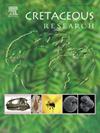欧洲罕见的ploplatecarpine翼龙是半全球性坎帕尼亚海洋脊椎动物动物群的进一步证据
IF 1.7
3区 地球科学
Q1 GEOLOGY
引用次数: 0
摘要
对俄罗斯Saratov地区Beloe Ozero地区Campanian Rybushka组的mosasauric材料的研究表明,在属水平上可识别的plioplatecarpus是唯一的plioplatecarpus。在其他丰富的北美厚板松林中,这个罕见的属只从几个标本中被知道。来自俄罗斯的新plioplatecarpus材料包括分离的但保存非常完好的颅骨和颅骨后部分,包括上颌骨、牙列、额骨、翼状骨、方骨、颅脑碎片、胸带和椎骨,其中大多数颅骨遗骸可称为Latoplatecarpus . willistoni。考虑到与北美相比,欧洲坎帕尼亚地区的plioplatecarpine化石记录极其稀少,来自Beloe Ozero地区的标本为该群体的古地理提供了新的线索。北美洲以外的Latoplatecarpus的记录表明,该属的地理和地层分布明显更广。这进一步证实了先前的证据,即许多沧龙类群在大西洋各地都有分布,而西部内陆海道和欧洲大陆外海的坎帕尼亚海洋脊椎动物类群有许多共同的类群。本文章由计算机程序翻译,如有差异,请以英文原文为准。
The rare plioplatecarpine mosasaur Latoplatecarpus in Europe as further evidence of a semi-global Campanian marine vertebrate fauna
The study of mosasaurid materials from the Campanian Rybushka Formation of the Beloe Ozero locality (Saratov Region, Russia) revealed that the only plioplatecarpine taxon identifiable at genus level is Latoplatecarpus. Among other abundant North American plioplatecarpines, this rare genus is known from only a few specimens. New plioplatecarpine material from Russia comprises isolated but exceptionally well preserved cranial and postcranial elements including maxilla, dentary, frontals, pterygoid, quadrates, fragment of braincase, elements of pectoral girdle and vertebrae, from which most cranial remains can be referred to Latoplatecarpus cf. willistoni. Considering that Campanian fossil record of plioplatecarpines is extremely scarce in Europe compared to that from North America, specimens from the Beloe Ozero locality shed new light on paleogeography of the group. The record of Latoplatecarpus outside of North America demonstrates that this genus had a significantly wider geographic and stratigraphic distribution. This augments previous evidence that many mosasaurid taxa had cosmopolitan distribution across the Atlantic, and that Campanian marine vertebrate faunas of the Western Interior Seaway and European epicontinental seas had many taxa in common.
求助全文
通过发布文献求助,成功后即可免费获取论文全文。
去求助
来源期刊

Cretaceous Research
地学-地质学
CiteScore
4.10
自引率
19.00%
发文量
235
审稿时长
12 weeks
期刊介绍:
Cretaceous Research provides a forum for the rapid publication of research on all aspects of the Cretaceous Period, including its boundaries with the Jurassic and Palaeogene. Authoritative papers reporting detailed investigations of Cretaceous stratigraphy and palaeontology, studies of regional geology, and reviews of recently published books are complemented by short communications of significant new findings.
Papers submitted to Cretaceous Research should place the research in a broad context, with emphasis placed towards our better understanding of the Cretaceous, that are therefore of interest to the diverse, international readership of the journal. Full length papers that focus solely on a local theme or area will not be accepted for publication; authors of short communications are encouraged to discuss how their findings are of relevance to the Cretaceous on a broad scale.
Research Areas include:
• Regional geology
• Stratigraphy and palaeontology
• Palaeobiology
• Palaeobiogeography
• Palaeoceanography
• Palaeoclimatology
• Evolutionary Palaeoecology
• Geochronology
• Global events.
 求助内容:
求助内容: 应助结果提醒方式:
应助结果提醒方式:


